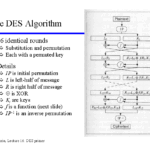Hill’s Cipher, conceived by Lester S. Hill in 1929, was a revolutionary advancement in the field of cryptography. A polygraphic substitution cipher, Hill’s Cipher utilizes linear algebra, particularly matrix multiplication, to encrypt messages. However, despite its intriguing mathematical foundations, Hill’s Cipher is increasingly regarded as obsolete and vulnerable in the modern landscape of cryptography. What might have been a bastion of security in its time seems to pose a puzzling question today: why is it that this cipher, once celebrated for its sophistication, is now largely dismissed as unreliable? Let us unravel the fabric of this once-prominent cipher and understand its contemporary limitations.
To glean insight, we must first delve into the mechanics that define Hill’s Cipher. At its core, the cipher operates by encoding plaintext into matrices, transforming these matrices through multiplication with a key matrix, which is the crux of its encryption process. The security of Hill’s Cipher largely hinges on the key matrix being invertible, revealing the elegant yet simplistic nature of its encryption. However, this very simplicity becomes an Achilles’ heel in the era of sophisticated attacks.
One considerable limitation of Hill’s Cipher is its susceptibility to known-plaintext attacks. In an age where adversarial entities can analyze intercepted messages, such attacks can undermine the integrity of a cipher quickly. If an attacker can acquire both the plaintext and its corresponding ciphertext, they can employ matrix algebra to deduce the key matrix with relative ease. The algebraic nature of Hill’s Cipher, while fascinating, makes it alarmingly straightforward for those with a mathematical background to exploit.
Moreover, the requirement that the key matrix must be invertible presents an additional constraint. The size of the matrix directly correlates to the amount of plaintext that can be encoded, yet it also limits the number of possible key matrices. Given a fixed size, the potential keyspace shrinks significantly compared to other ciphers designed for greater complexity. In a world increasingly driven by computational power, this limited keyspace means that brute-force attacks become feasible, rendering the cipher’s security dubious.
As we navigate through the historical prowess of cryptographic techniques, it becomes evident that a cipher’s longevity hinges on its adaptability to evolving threats. Hill’s Cipher is, unfortunately, rigid in its structure. The absence of diffusion—a principle where the influence of a single plaintext symbol is spread over multiple ciphertext symbols—is stark in Hill’s method. The linearity of matrix multiplication lacks the non-linear complexity offered by contemporary ciphers like the Advanced Encryption Standard (AES). The result is a cipher vulnerable to frequency analysis, enabling cryptanalysts to discern patterns within the ciphertext, thereby exposing the plaintext.
When considering the practical applications of Hill’s Cipher, the limitations amplify. In commercial environments where sensitive information is transmitted, the need for robust encryption techniques is paramount. Organizations require cryptographic systems that can thwart evolving cyber threats, maintain confidentiality, and ensure data integrity. Hill’s Cipher cannot meet these demands adequately. Its inherent weaknesses compel organizations to seek more sophisticated options, often leading to its relegation to historical study rather than active use.
Another caveat of Hill’s Cipher lies in its inability to accommodate larger key sizes seamlessly. With the advent of quantum computing on the horizon, the urgency for encryption methods that can withstand this new computational frontier cannot be overstated. Hill’s Cipher, with its finite matrix dimensions, cannot easily expand or adapt to larger key sizes without compromising its original framework, thereby making it ill-suited for the demands of future cryptographic applications.
Interestingly, the fascination with cryptography often lingers in contrived places, including popular culture and gaming. Hill’s Cipher might allure amateur cryptographers or hobbyists intrigued by its mathematical elegance. However, in practical applications, one could argue that reliance on Hill’s Cipher is akin to navigating treacherous waters while pursuing knowledge; the aesthetic beauty of the method can easily obscure its inherent dangers.
Scholars and cybersecurity experts continue to analyze the past, and Hill’s Cipher serves as an educative tool for understanding the evolution of cryptography. Its initial elegance and mathematical intrigue serve as a foundation for contemporary encryption methods, yet these very traits become the stark reminder of the limitations that render it an obsolete choice in practical scenarios. The examination of Hill’s Cipher highlights the importance of adaptability and security in cryptographic practices.
Ultimately, the question remains: can a cipher like Hill’s evolve to meet the sophisticated demands of modern cybersecurity, or is it destined to remain a footnote in the annals of cryptographic history? As we navigate this landscape, one recollection remains pertinent; as technology evolves and threats proliferate, so must the techniques we employ to safeguard sensitive information. Hill’s Cipher stands testament to the relentless march of progress in cryptography—a relic of a bygone era, illustrative of both its early brilliance and its unfortunate vulnerabilities.








Leave a Comment